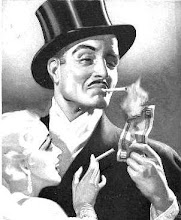I should have just left good enough alone. The Street & Smith part of the ending of the last piece was a bit muddled. It's one of those cases of running off at the mouth us armchair history buffs do on occasion.
Sometimes you've said enough and you need to leave it at that. My intention on doing the Dime Novel piece was to say a few things about them broadly, outline their history broadly and then get out without mentioning too much about Character Management, which is actually the third part of our trifecta on the Story Paper and Dime Novel era. This is really where Street & Smith comes in. They are fairly much the best bridge into the pulp era and I have a whole heck of a lot to say about their specific method of doing business. Just not in a general overview of Dime Novels, where it just muddies the water.
So I muffed it. I explained the three eras of Dime Novels. I explained the three products. And I explained the domination of reprints in the form. That really should have been good enough.
Street and Smith somewhat dominated the last era of Dime Novels. A lot of people got into the neo-pulp format in the last phase of Dime Novels, Street & Smith included. A neo-pulp is a slick covered Dime Novel. These are the Dime Novels of the 1890s. Just as everyone dressed up their reprints with spray on color during the last nostalgia craze, everyone dressed them up in slick covers during the 1890s Dime Novel revival. And a lot of Story papers made the switch and some new publishers, like Courtland Young, jumped in having never been in the industry before. Some of the Gay 90s nostalgia that followed was for these newer magazines and not completely for the other Dime Novels. Completely delineating what each nostalgia craze was about I felt was beyond the scope of a piece on Dime Novels, but not doing so leaves the wrong impression. As it should happen, we do have a blog entry specifically about Gay 90s nostalgia (Ask Me About Gay 90s Nostalgia.)
Street & Smith was no better or worse than any other firm when it came to reprinting. If they produced another firm's titles, it was during the Civil War nostalgia crazes and not the Gay 90s ones. For the Gay 90s, they had plenty of their own titles to dredge up. In no way do I want to make Street & Smith look better or worse than any other firms in the field. There was a point where they actually did withdraw Nick Carter for a period of time. He wasn't that extensively reprinted. On the other hand, Buffalo Bill Cody was dragged through the Dime Novel recycle bin for decades after his death. It really just depended on what sold--or still sold-- and not necessarily on nostalgia for the entire Dime Novel field.
Much of Beadles works wound up in the hands of novelty houses, two of whom had actually started in Dime Novels to begin with. Dime Novels were a mail order business. Some of the firms didn't quit, just because the field had folded up. In many ways, the Dime Novels were connected to the growth of the overall novelty industry. There's a good reason they lasted longest in little gift shops--supplying such was what the publishers did as their main line. Beadle's and Munro's works wound up first in the hands of M. J. Ivers & Co, itself a Dime Novel house and then in Arthur Westbrook Co, which later has successors in interest in the pulp trade.
***
Next: We will have an update on New from the Pulp World and Magazines. After that, I am hoping to do a piece on Character Management, then I hope to find my notes on Ideal Magazines and present that. More details in our next posting. Aloha.
HIL-GLE MIND ROT MODERN THRILLS QUALITY CREATIVE NEWSSTAND FICTION UNIT WONDERBLOG Shy people can contact us directly via email at Wunker2000 at Yahoo dot com.
Visit HIL-GLE Today!
Monday, April 25, 2011
Subscribe to:
Post Comments (Atom)
Search the Wonderblog!
Blog Archive
COMMIT TO INDOLENCE!

Ajax Telegraph, Chicago IL

No comments:
Post a Comment